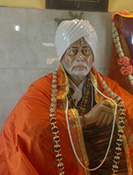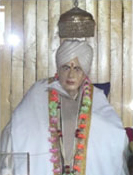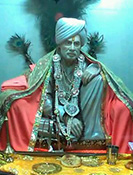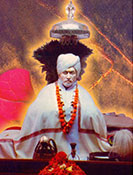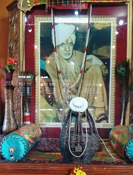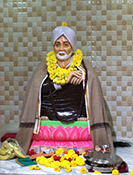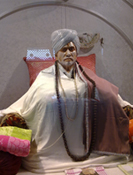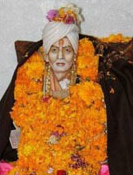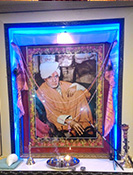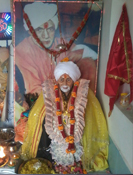"Wonderful Asana of Bhagavaan Ji”
Various are the forms of the Saguna Bhagawaana. He descends to uphold the dignity of mankind. He does some miracles, just to help the needed with his Yogic power. He lives always absorbed in the Yoga Bhaava, which is the transcendental nature of Shiva.
In the present era, we have around us the vibrations of “BRAHMA BHAAVA and YOGA BHAAVA” of Shriman Bhagavaan Gopinath Ji. Today He is not in His physical body, but His Sukshma Sharira / Subtle body is always ready for our spiritual guidance inspiring us with His Abhaya Mudra. These are to be realized, through our Samarpan / dedication, Bhakti / devotion and Tapasya / austerities.
How to visualize the Brahma Bhaava of Bhagavaan Ji?
We are blessed with his Murta Bhaava in the form of a CHITRA / image graph, taken once, during his last ten years of Sadhana at Chandapora Habba Kadal.
The Chitra is captioned as: Bhagavaan Gopinath Ji at Chondapora (Habbakdal) : Asana1957-68
His Enchanting Symbols are:---
- RUDRAKSHA-MALA: Rudraksha is related to Bhagavaan Shiva. Literally, Rudraksha means the Tears of Rudra. Rudra is the Divine Being adored in theYajurveda. Kashmiris recite the Rudra Mantra for the eco-balance of the globe and for personal spiritual evolution. Shiva Purana reveals the episode of SATI, who entered the Yoga Agni at the Altar of Daksha Prajapati, on the ground when Lord Shiva was not invited to receive Daksh’a Homa Ahuti /sacrificial portion. This made SATI-- the daughter of Daksha sad, and made her sacrifice her own being to redeem the honour of Shiva. This is known as Shiva Bhakti. Shiva could not withstand that situation, hence through His emotive Krodhagni, His RAUDRI tears fell on the sacred spots of the Himalayas , which eventually developed into a tree, bearing the Rudraksha seed. This Rudraksha bead is either of Five Faced or Single Faced. Bab Bhagavaan Ji would wear the PANCHA-MUKHI RUDRAKSHA MALA around his neck, knotted with the White beads known as Laudr’u Daan’u in Kashmiri dialect.. The composition of the Mala worn by Bhagavaan ji suggests that Purusha and
Prakriti are woven to form the intellect and emotion together for theGrihastha and Sannyasa. Both these attributes are linked with BAB JI. The visible Nine Lodr’u beads signify the Nava Durga aspect within the Shaivi-state of mind of the Bab Bhagavaan Ji. The Mala is projected in the Savena form, meaning adoration to the Devatas. - Container of Religious Books : A house holder is required to have the religious books, known as the sacred books in the home, so that the proper Sanskaras be given to the posterity. Also keeping of sacred texts in the basket as shown reveals that the sacred texts are for the religio-spiritual guide lines. These texts were the Shiva Purana, Bhavani Sahsranama, Guru Gita, Bhagwadgita, Panchastavi. These are all for the coordination of “Dharma-artha-kama-moksha” the four segments of human aspiration.
- Stock of Tobacco: Since Bhagavaan ji would smoke, for being absorbed in the higher ecstasy, so the tobacco was put in a big canister. It was not open, meaning that such things are not for the comon devotees, but for those, who could contain themselves after being addicted to such things. It was just; like a Halahala as Lord Shiva absorbed to save the Devataas, from the wrath of the Raakshasas.
- Towel is known as the Prakshalan Patta in Sanskrit. It would always be on the right hand side of the Bhagavaan Ji on his pillow. Since Kashmiri Pandits would handle the KHOS for taking tea, with a towel, therefore, it is a guide line for all of us to take tea not with bare hands, but with a towel, to maintain the sanctity of what we take or drink. Care should be taken that water tumbler should be wrapped with a towel, to maintain the ancient Kashmiri Pandit ancient heritage.
- CHIMTA is TONGS in English language. It happened to be an Ayudha/weapon for keeping the burning Samidha within one’s control. It is an iron consisting of two arms hinged and fastened together, for seizing, holding or lifting the burning charcoal. It is to seize the Ahankara within and to put it within the flame of Gyaana, so that ego is turned into ashes. This instrument is also used for singing a Kitrtana to glorify the Ishta Deva.
- AHUTI is an integral part of the Vedic Anushtthans/ invocation to the Devatas. It comes under the injunctions of the Vedic Homas. The Vedas Say:- asmai devaaya havishaa vidhema, which means an enquiry of the Rishi about the name of the Devata to whom the Ahuti/ oblation be offered. Bab Bhagavaan completes the Mantra with, Tailokya Nathaaya, Trikoti Devataayai havishaa vidhema.
“I am giving the Ahuti/offering to the Supreme Divine being, who is the Controller of the Triloka, where Trikoti Devatas find their abode”. Giving of Ahuti in the name of the Devatas, is highly acclaimed in the Kashmiri Pundit tradition, as the offering of the Ahuti makes the person in close connection with the Divine, The Ahuti is for the eco-balance of the globe, as well Ahuti is for the Vaishva Deva, who is invoked with the prescribed Vedic Mantra. - BABOOTI is very dear to Mahadeva. Babhhot means the essence of what has been offered to the Trikoti Devatas, through Agni Devata. Babut can be termed as the Pure Sattva, as it is of the remains of the Shuddha- Ahuti Lord Shiva gets highly pleased with the application of the Bhaboota,on the forehead of the devotees. Therefore, Bab Ji would apply the Babooti Bindu within his Tilkam.. Bab Ji would use this BABOOT for the healing purposes. Since the Baboot happened to be sanctified with the RUDRA-Pattham, and the Bahurupa Garbha Mantra, including the Panchastavi and
Indrakshi , It would get the higher potency as per the Shaivistic and Shakta scriptures. Babboti happened to be the essence of the Sadhana of Bhagavaan ji. - CHILLUM is the earthly consciousness of Bab ji. It is made of clay, Its design is the Prassar/expansion of the Shiva-consciousness, from the design, as Bab Ji had it. While puffing at the Chillum, the Yogi’s Prana travels inside and touches the very core of the Manipura Chakra. It is related to the Yogi, who surrenders all his thoughts on Shiva, and thus attains Samadhi. Bab Ji would experience that, through the puffing of Chillum.
- Kani Pa~itir or Stone Sheet is linked with the Shailaputri aspect of the Durga. It is the base of the Yoga. The great saints do keep it for getting the Shailaputri vibration, as the Paitir is directly linked with the Bhu Devi. For BAB Ji, Shri Sharika is the SHAILA-PUTRI, as He used to play with the Nava Koti Murtis of the Hari Parbat.
- Kani Pal/ Stone Slab is the identity of the Shiva and Shakti, which is known as the preparation for the” Annapurna ” in the Kashmir Shaivistic Nirvaana-Paddati.
- This is the second stage towards reaching the Shikhara of the Chakreshvara, closely related to the BHAAVA MUDRA of BAB Ji..
- Shastur Manan Iron Stove, is to ward off all the evil forces from the environment, and to keep away the effects of Shani/Saturn. Otherwise, iron Kunda has not been recommended in the Homa’Agni, but Bab Ji would give Ahuti to the Deities in this iron Kunda. It can be said that BAB ji was doing his Tantrik oblations as well; The Tantriks use the iron pots in their Homas.
- Dhoni is linked with the Aghora worship. It must be burning constantly. It is known as the CHIT AGNI SAMBHUTTA, which happens to be the altar fire of consciousness. Dhooni is the best explanation of human life. Dhooni needs to be preserved, as the body needs to be preserved for keeping the Yoga, within the orbit of Mooladhaara and Sahsraara Chakra. Dhooni carries Ahuti to the Deities, who are revered as Dik Dikpals, Dhakini-Shakini-Sakibni-Chkara Vakini, the Bhairava and Bhairavi.
- Tobocoo for Chillum. The Chillum of BAB Ji is the Shiva Swaroopa , and the tobacco itself is the materialistic manifestation, which needs to be burnt, for reaching the higher state, where Dhyana would deepen the Dharana—fixity in the Samadhi.
- Chimtta for Chillum is to be used as an instrument not to touch the fire, but use it with care, so that the devotees would feel that small instruments do carry significance in their Sadhana. It is to select the burning coal from the ashes, which lie hidden under the coal ash of Tamas/ignorance.
- Gagar / Water container is the Hiranyagarbha of the Vedas. It is the projection of the Brahmanda, where Varuna is the Deity of excellence. All the Kalash Puja is dedicated to Varuna Devata. . A tumbler full of water is the maximum satisfaction, which BAB ji would get, as He would keep the water resources filled for the humanity.
- Bolster/ Takiya. It is a long under pillow for a bed. It is a support for rest. The body of the Yogi must always be in equipoise; hence the bolster would serve the purpose. It keeps the physical body in harmony within Dharanaa/Yogic fixity.
- Chaadar / Blanket is to cover the body from severe cold. Some times, the Yogis want to hide themselves, or to do Sadhana in dense dark during day time also, hence BAB Ji would wrap himself with the blanket. It serves as an apron during Sadhana.
- Gadda with Drinking water is not for personal use alone. He would keep that ready for the Devatas, as they would get Abhishekam from the Saint-extraordinary.
- Wati Pod or a way through is for the constant Reception to the Devatas. They would walk through the Sadhana Sthala of BAB Ji and communicate with him.
- Tika Katsul, is for using in the Panch-Upachaar Puja, Dash -Upachaar Puja and the Shodasha Upachaar Puja of the Ishta Devi Shri Ragnya and the Presiding Deity of Kashmir Shri Sharika. He would invoke His Devis, and would apply Tyok/ Tilkam'Gandham to the Divine Mother and on His forehead as is seen in His Photograph. The pituitary gland gets charged through the Tilkam applied on that spot. It is also known as the TRINETRA of Shambhu.
This Asana is the COSMIC CONSCIOUSNESS of Bhagavaan Ji in the SAHAJ MUDRA, dedicated to Mata Tripura Sundari. Seeing carefully at the Asana, it appears to me the Hianyagarbha form of Bab Bhagavaan Ji.
(Write up is based on my limited perception, but with devotion) ----- Dr. Chaman Lal Raina






